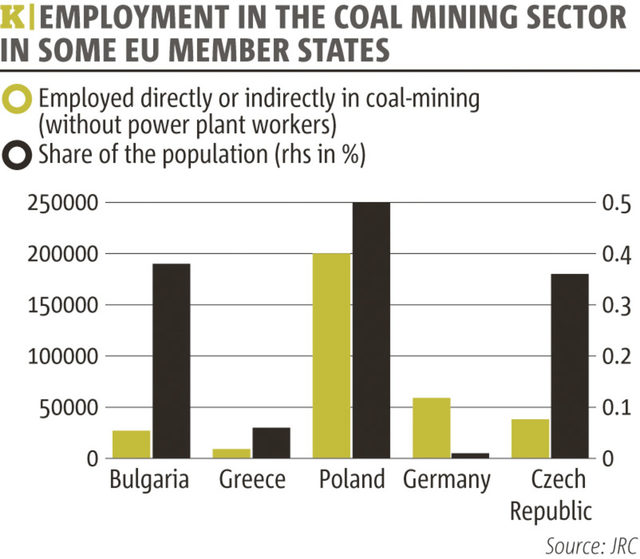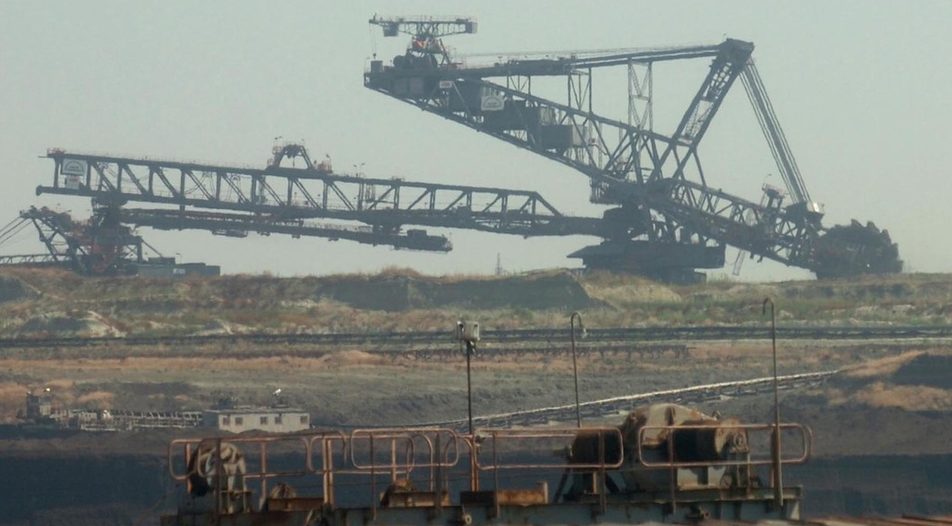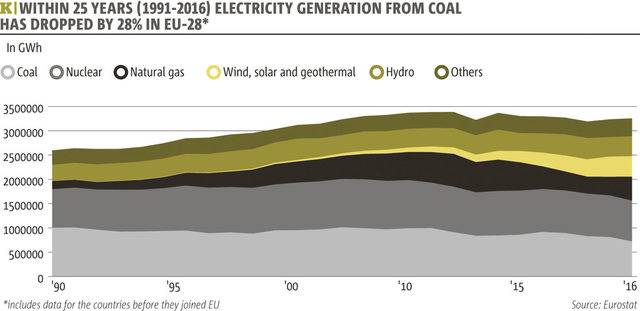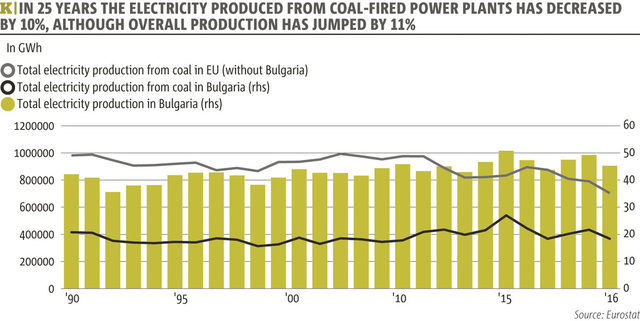| - Barring any dramatic policy U-turn, coal-fired power plants in Bulgaria are set to close by 2030 - Miners and power plants still have a chance, but the clock is ticking to enforce major changes to Bulgaria's energy policy |
When it comes to coal, it seems that Brussels and Sofia not only do not share the same continent but inhabit different planets. Just as the European Commission published its economic strategy targeting zero carbon emissions by 2050, Bulgarian trade unions demanded government guarantees to safeguard coal miners' jobs until coal reserves run out, i.e. until 2080. And the Minister of Energy Temenuzhka Petkova quickly obliged.
"Europe wants to close mines down; it wants to stop us mining coal, overlooking the fact that without the Maritza Iztok mines, we have no life," said Ivo Zmeev, one of the miners protesting in front of the government building in November 2018.
People like Mr Zmeev, whose entire family is also employed in the mining industry, are usually accused of shortsightedness, clinging to their livelihood and not seeing any future beyond coal. However, the 27,000 people directly or indirectly employed in the coal mining sector and coal-fired power plants have plenty of cause for concern. Their future is threatened by the Bulgarian authorities who prefer to sweep problems under the carpet.
Despite the persistent urging of the European Commission and although the problems are crystal clear - without taking immediate action the coal-fired power plants will have to close before 2030, Bulgaria is the only EU country with a considerable share of coal in power production to shun the EU's programs for coal mining restructuring. Poland, a vocal defender of its coal sector, which employs a quarter of a million people, is very active in seeking solutions to the impending shutdown of the coal industry. Against this backdrop, Bulgaria seems to have firmly buried its head in the coal.
Over the past several months, Ms Petkova has assured miners that Bulgaria will not support the EU's lofty ambition to fight climate change which calls for rapid decarbonization of the European economies. However, such declarations can't reverse the demise of coal in Europe. If it had wanted to avoid major social and economic distress, then Bulgaria's coal mining sector should have already started restructuring. It has less than a decade before power plants and excavators are halted. Therefore, any delay will only add to the hardship of the sector's tens of thousands of employees.
The coal's horizon
The future fate of coal hinges heavily on the EU's new environmental standards adopted in 2018. They cap sulfur dioxide (SO2), nitrogen oxides (NOX) and mercury emissions - three real pollutants, unlike carbon dioxide (CO2), at levels that are technically attainable but require serious investments to modernize Bulgaria's coal-fired power plants. The three big ones - the state owned Maritza Iztok 2 and the two privately held - AES Galabovo and ContourGlobal Maritza Iztok 3, hired a consultant last year to assess the cost of meeting the new standards.
The investment has been forecast at 500 million euro. Such an amount hardly makes sense for the three power plants which face dwindling revenues.
On the one hand, electricity production from renewables squeezes their market share and on the other, expensive CO2 allowances make their production economically viable only during rare peak hours.
As a result of these two factors, Maritza Iztok 2 already faces a major financial crisis, unable to meet its short-term obligations. At the same time, AES Galabovo and ContourGlobal Maritza Iztok 3 face constant pressure to abandon their lucrative long-term power purchasing agreements which guarantee them above-the-market prices.
The EU's climate policies foresee coal power plants disappearing in fifteen to twenty years and many countries are already setting dates to phase them out. For example, Belgium decommissioned its last coal-fired power plant in 2017, Portugal plans to do so in 2022, France in 2023, the UK and Austria in 2025, the Netherlands in 2030 and Germany in 2038. Ptolemaida-5, now under construction in Greece, will probably be the last coal-fired power plant built in the EU. Even Poland, which produces 90% of its electricity from coal, has no plans for new coal power plants after 2019.
Such a narrow time frame makes it very difficult to recoup the investments needed to meet new environmental standards. This is forcing the coal-fired power plants to apply for derogations, i.e. temporary exclusion from new environmental stipulations that will come into force in 2020. In principle, derogations can last no more than seven years. And once they expire, the power plants need to be closed or modernized in order to meet the even higher revised environmental standards which the EU will undoubtedly have accepted by that time.
Most probably, because of the requested derogations, the European Commission's Joint Research Center forecasts that by 2030 only one coal-fired power plant will remain in Bulgaria. In its report on the future of coal, it predicts that only the most modern power plant - AES Galabovo, will still be running ten years from now.
The second factor putting pressure on coal-fired power plants is the ban on capacity payments for any installation emitting over 550 g of CO2 per one kWh of electricity. Currently, Bulgaria's electricity grid operator and the National Electricity Company pay some electricity producers to just operate on standby. This helps those power plants maintain some of their revenue when there is reduced demand during the summer and preserves a healthy reserve for the energy system in case of severe shortages.
As of July 1, 2025, however, Bulgarian coal-fired power plants won't receive further such payments for available capacity because they exceed more than twice the mandated emission threshold and there is no technical solution to this problem.
Currently, during peak demand in December and January, wholesale prices triple. Without capacity payments, power plants will need to ask significantly higher prices to maintain their revenue. Such a hike is hardly possible, which will mothball some coal-fired power plants.
The rising price of CO2 allowances is the next factor determining the bleak future of coal. Power plants are required to buy one allowance for every ton of CO2 emitted. Until recently, the CO2 allowance price fluctuated between 5 and 9 euro, an additional 30-45% overpower plants' variable costs. However, prices skyrocketed to 20-25 euro in 2018 following the European Commission's decision to withdraw some of the allowances available for sale.
The more expensive CO2 allowances made the coal-fired power plants' electricity uncompetitive on the market, except during rare peak hours. This was the main reason for mounting losses at Maritza Iztok 2 over the past two years.
The prices of allowances will most probably stabilize at these levels, at least in the foreseeable future. However, the European Commission forecasts that the price will reach 30 euro by 2030, while other estimates, for example, those of independent consultants Carbon Tracker, forecast 40 to 50 euro for the right to emit one ton of CO2.
EU legislation, which requires 35% of the Member States' final energy consumption (including transport, industry, agriculture and other sectors) to come from green energy sources by 2030, does not offer much hope for the coal industry either. For Bulgaria this means a doubling of the share of renewables in final energy consumption. In the electricity sector, in particular, green energy must reach about 40% of total consumption (currently around 19%). All else being equal, coal-fired power plants would lose half their domestic market share.
These four negative factors combined will have a devastating effect on any attempts to build or modernize coal-fired power plants after 2020. There will be no bank or private investor who will invest in their future. Only state aid can keep coal-fired power plants afloat for a while.
Sleepy Bulgaria
While every country with a significant coal sector is busy finding alternatives, or planning how to deal with the social and economic consequences of the inevitable demise of the coal industry, Bulgaria seems indifferent.
Unlike Germany, Spain, Poland, Greece, Romania, the Czech Republic and Slovakia, Bulgaria didn't participate in the EU's pilot program Coal Regions in Transition. The European Commission's vice-president Maros Sefcovic urged Sofia to apply but the government failed to prepare the application letter.
The program aims to find sustainable employment in the regions with high dependence on coal. It finances industrial zones, data centres or alternative energy projects. A large part of the infrastructure around the power plants in the Maritza Iztok coal mining region has easy access to industrial-grade electricity supply and good connectivity and should be ideal for such projects.
Bulgaria has no participation in the current EU innovation fund, which supports advanced technologies in the energy sector. While it is true that the projects require a serious technological and scientific potential, Bulgaria's scientists and Bulgarian Academy of Sciences could have at least participated as members of larger teams.
The Bulgarian government does not show any inclination to catch up. Sofia needs to be ready by the middle of 2019 with plans for participation in the new EU programs post-2020. The future innovation fund will have around 10 billion euro for supporting advanced technologies like CO2 sequestration or power-to-gas demonstration projects (i.e. turning excess electricity into hydrogen and natural gas). If Bulgaria wants to take part, it needs to make serious preparations but these are non-existent at present.
After 2021, Bulgaria will again be able to allocate for free 40% of its CO2 allowances to companies that emit carbon dioxide. However, unlike at present, the European Commission will monitor much more stringently the use of the money. Companies should use the savings only for decarbonization projects.
This is one of the few possible sources for financing the modernization of power plants. For example, the money can be used to meet the EU requirements for SO2 and NOX emissions, forgoing the need for derogation from the environmental rules. If the power plants meet upcoming environmental standards, they will have the chance to work after 2030 (when they will be able to request derogation from future eco-requirements).
What about the miners?
Some 350 million euro (the exact amount depends on the cost of emission rights) in the EU's modernization fund is allocated to Bulgaria after 2021. The fund supports programs in countries with GDP below 60% of the EU average. Its resources can be used to modernize energy infrastructure (without benefiting the coal-fired power stations) and support social measures in regions heavily dependent on coal.Bulgaria urgently needs such support. The number of employees at Maritsa East Mines has not decreased in recent years, although in 2011 an analysis of the then Ministry of Economy and Energy claimed that at least one-third of the seven thousand workers should be laid off. In 2010-2013, modest staffing cuts were made but numbers recovered later. Over-manning not only creates financial problems for Maritsa East Mines but also increases the upcoming social shocks of redundancies.
Resources from the modernization fund and state aid (the European Commission allows it for such purposes) could help many miners find new jobs and diversify the region's economy away from coal. Now, when the labour market in Bulgaria is hungry for every available hand, it's much easier to restructure the sector that does so during a crisis.
Change in energy market needed
Only two strategies exist for coal-fired power plants to survive until there are viable alternatives. They could cut down on operations and demand exorbitant prices when electricity is needed. This would open large gaps in electricity supply during non-peak hours because renewables simple can't be deployed in such big numbers in such a short time. In addition, consumers will not be amused when they see prices five to six-time higher during peak hours.
The second option is for the power plants to receive state aid. Most EU countries have already begun to set up capacity markets which support electricity producers to stay on standby. The former leader in market liberalization in the energy sector - the UK, was the first to do that as early as 2014. The scheme was rendered illegal by the European Court of Justice in November 2018 but the UK government now attempts to reorganize the capacity payment system.
The Bulgarian Ministry of Energy has already hinted that Maritsa East 2 power may be able to receive funds to maintain "strategic capacity". For more than six months there has been no information on what the authorities are doing. If the European Commission doesn't authorize the proposed capacity mechanism by the end of 2019 it can't be introduced, which will put into doubt the capacity payments to AES Galabovo and ContourGlobal Maritza Iztok 3 and will definitely cause havoc in the Bulgarian energy market. Both producers will hardly work without those payments.
If those two power plants are included in a national capacity mechanism, it will naturally integrate their power purchase contracts which are much criticized in the market. An additional benefit is the involvement of the European Commission. It will review the mechanism and if it finds that AES Galabovo and ContourGlobal Maritza Iztok 3 are overly compensated, it will remove the extra payments.
Such a mechanism will not be that expensive. At the moment, with the sharp rise in the price of CO2 emission rights, the state can use the windfall to rebalance payments in the energy sector and free some funds to support the coal-fired power plants without raising prices for consumers.
While not ideal, the solutions for the coal sector are clear. Coal mining should be winding down with some help from EU funds, while coal-fired power plants should be supported until a real alternative kicks in. But the Bulgarian authorities are dragging their feet.
One motive for the reluctance to come up with a new capacity mechanism could be the hope of breaking contracts with the two private investors. This has long been the goal of employers' associations that have the ear of the government. They think this will reduce electricity prices, but they rarely mention what breaking the contracts will entail - lawsuits and a possible shortage of power if plants close down. The other explanation could be that the authorities are attempting to keep some payments for uncompetitive producers.
The state aid guidelines of the European Commission explicitly forbid support for economically non-viable enterprises. One such example is Varna Power Plant, bought a year ago by Ahmed Dogan, the honorary chairman of the Movement for Rights and Freedoms party. Following the purchase, the idled power plant was restarted but it hasn't sold a single megawatt-hour of electricity since then on the free market. It now receives payments to be on standby from the Electricity System Operator.
In short, the coal sector faces a bleak future but there will be less pain if it gets promptly restructured from now on.

| - Barring any dramatic policy U-turn, coal-fired power plants in Bulgaria are set to close by 2030 - Miners and power plants still have a chance, but the clock is ticking to enforce major changes to Bulgaria's energy policy |
When it comes to coal, it seems that Brussels and Sofia not only do not share the same continent but inhabit different planets. Just as the European Commission published its economic strategy targeting zero carbon emissions by 2050, Bulgarian trade unions demanded government guarantees to safeguard coal miners' jobs until coal reserves run out, i.e. until 2080. And the Minister of Energy Temenuzhka Petkova quickly obliged.














